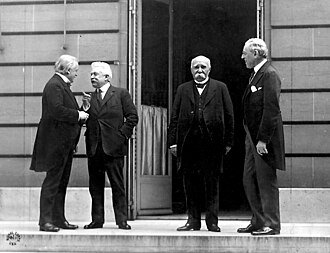The Versailles Peace Treaty
Signing of the Treaty
- The signing of this treaty was the end of the war.
- Germany was forced to sign the treaty, or else it would face occupation by Allied troops.
- A meeting was held in Versailles, in France.
- The treaty was formed by presidents Lloyd George of Great Britain, Vittorio Orlando of Italy, Georges Clemenceau of France and Woodrow Wilson of the United States.
- Japan was also part of the making of the treaty but did not have much importance.

- A picture of the four presidents. They are often called the "Big Four" or the "Peacemakers".
- Small countries such as Belgium, and Russia which had internal revolutions weren't as important and didn't get to make changes in the making of the treaty.
- Neither did the countries that had lost the war, namely Germany, Austria and Hungary.
- The Versailles Treaty aimed to destroy Germany's economy to prevent another uprising of their military, and couldn't construct a reliable peace.
- Germany would effectively be the only country blamed for The Great War.
- This was very harsh and untrue and it meant that Germany had to pay for the damages alone.
- This was somewhat justified as some countries such as Austria Hungary had dissolved.
- Kaiser Wilhelm II took exile in Holland.
- Imperial Germany was replaced by the Weimar Republic (which subsisted from 1919 to 1933).
Lost Territory
- German lost lots of territory from the Treaty of Versailles.
- Polish Corridor, a coastal area between Eastern Prussia and Germany.
- The Saar region, which had a powerful coal industry, was returned to French control for 15 years.
- Demilitarization of the Rhineland (Rheinland in German), which was a region in between France and Germany.
- This demilitarized area meant that Germany couldn't start a quick assault or prepare a defense in the area which didn't hurt Germany economically but weakened them.
- Approximately 13% of German area were handed over.
- Over six million Germans were left outside of Germany and became the territories of other countries such as Austria and Czechoslovakia.
Punishments and Restrictions
- France was very bitter after the war.
- France was in great debt to the United States.
- France applied huge reparation payments onto Germany (which they only paid back in 2010!)
- American President at the time, Woodrow Wilson made a 14-point plan for improving relations in Europe.
- This was attempted to be integrated into the Versailles treaty, although it wasn't implemented as the plan had intended.
- For example the League of Nations was developed.
- Germany faced great military restrictions.
- The size of their military was limited at 100,000 soldiers.
- They could use no modern weapons such as airplanes, tanks, submarines.
- Conscription was banned.
Consequences of the Treaty
- The treaty left Germany's economy weak for the time.
- Germany's military was greatly reduced in size and power.
- Germans felt that the peace was shameful (the term Schandfrieden in German).
- The treaty led to bitterness among the Germans.
- It would have been better if the treaty had been fair towards Germany which was one of Europe's largest economic powers, allowing the economy of Europe to recover quicker.
- Germany had been weakened by the treaty although it was in a situation where it could easily recover.
- The treaty hadn't formed constructive peace either so it was unsuccessful in maintaining peace.
Image Sources
https://commons.wikimedia.org/wiki/File:Big_four.jpg
